Introduction
Photographers Richard Misrach, Peter Goin and Jack Fulton bear witness to the value of photography and their relationship with the natural world. Richard Misrach1 has been exploring human being’s relationship with environment along his career as a photographer for over forty years. He is best known for his ongoing series Desert Cantos. His large-scale landscape photographs are remarkable and highly influential for photographers of his generation. He pays attention to dramatic weather systems and human intervention while try to trascend place and time from the language of photography. Artist Peter Goin2 is a Foundation Professor of Art at the University of Nevada, Reno, and he is autor or co-author of numerous books, including Tracing the Line: A Photographic Survey of the Mexican-American Border; Nuclear Landscapes; Humanature; Changing Mines in America, or Colors of California Agriculture, among others. Originally trained as a political scientist, he discovered that politics was more about power than ideas, and now Goin is a photographer who serves as a witness of the evolving landscape in the Great Basin and beyond. Finally, the Bay Area photographer Jack Fulton’s work3 comes to a prodigious process of creativity and experimentation. His commitment and passion for photography drives his way of relating to nature. Fulton served as a photography professor at the San Francisco Art Institute in 1969, and he made the photography department an inspirational program. His creative work is full of live and imagination, as a result of the engagement of Fulton with the social and cultural changes.
These three American photographers make us think of landscape photography as an emotional language that allows us to deeply understand nature. These three interviews were made to the aforementioned artists during a research stay in Berkeley in 2018, and they were truly generous and acommited. I must say that their answers have provide us a magical sense of environment through photography. Their appealing approaches have transformed our way of seeing the altered world. It is have been a pleasure to have shared stimulating conversations about landscape and photographic creation with these artists. Their words come as a breath of fresh air in the current changing society.
1. Exploring the photographic world of Richard Misrach
M.A. Blanco: I have been researching on human-altered landscape photography for years, and I pay special attention to intersections between aesthetic and environmental features found in contemporary photography. While a new form of nature is being built by humans being today, many photographers reflect on society’s relationship with nature. I believe this is a key issue today, mainly in California. After my brief stay in Berkeley I feel myself very enthusiastic because of the strong environmental awareness, which makes me think of the relationship between culture and environment. I ask myself if photographers are reinventing landscape in the 21th Century. Your photographs make me think of a multidisciplinary approach, and I am aware of its social feature. Also, I wonder if you have painting references that, in some way, influences your work. Please, could you tell me about this?
R. Misrach: Certainly, painting has influenced my work. In some of my series (the Desert Cantos project of the last 40 years), like my sky canto, “field painting” (Rothko, Barnett Newman, Ad Reinhardt, et al) is intended as reference. In my scrub canto, I am playing with Jackson Pollock. And of course, in my book, Pictures of Paintings, I photograph details of realistic paintings (often based upon photographs), I am creating a hall of mirrors: photographs of paintings based on photographs.
M.A. Blanco: Besides, I am truly interested in knowing more about the process of your work. I guess that total inmersion in landscape and exploring nature is a way of experimentaion for you. Could you tell how you plan your trips, how long they are, and the usual process until you get your images?
R. Misrach: For my main focus of recent years, the Desert Cantos, I have traveled around the American southwest looking for ideas that more broadly represent the US, even global conditions. I have either thrown my camera and tripod in the back of a VW van, or more recently rented a 4x4, and wandered without expectations. I travel for 10 days to 3 weeks, just chasing the light (i.e., looking for cloudy weather to afford me more interesting light conditions). I learned years ago that leaving with a preexisting idea usually yields nothing of interest. I eventually learned that by just traveling with an open mind—I call it being “aggressively receptive”—I would discover great projects. Over the years, I came upon man-made floods, fires, bombing ranges, space shuttle landings, the militarization of the US/Mexico border, etc. (each of these becomes a desert canto).
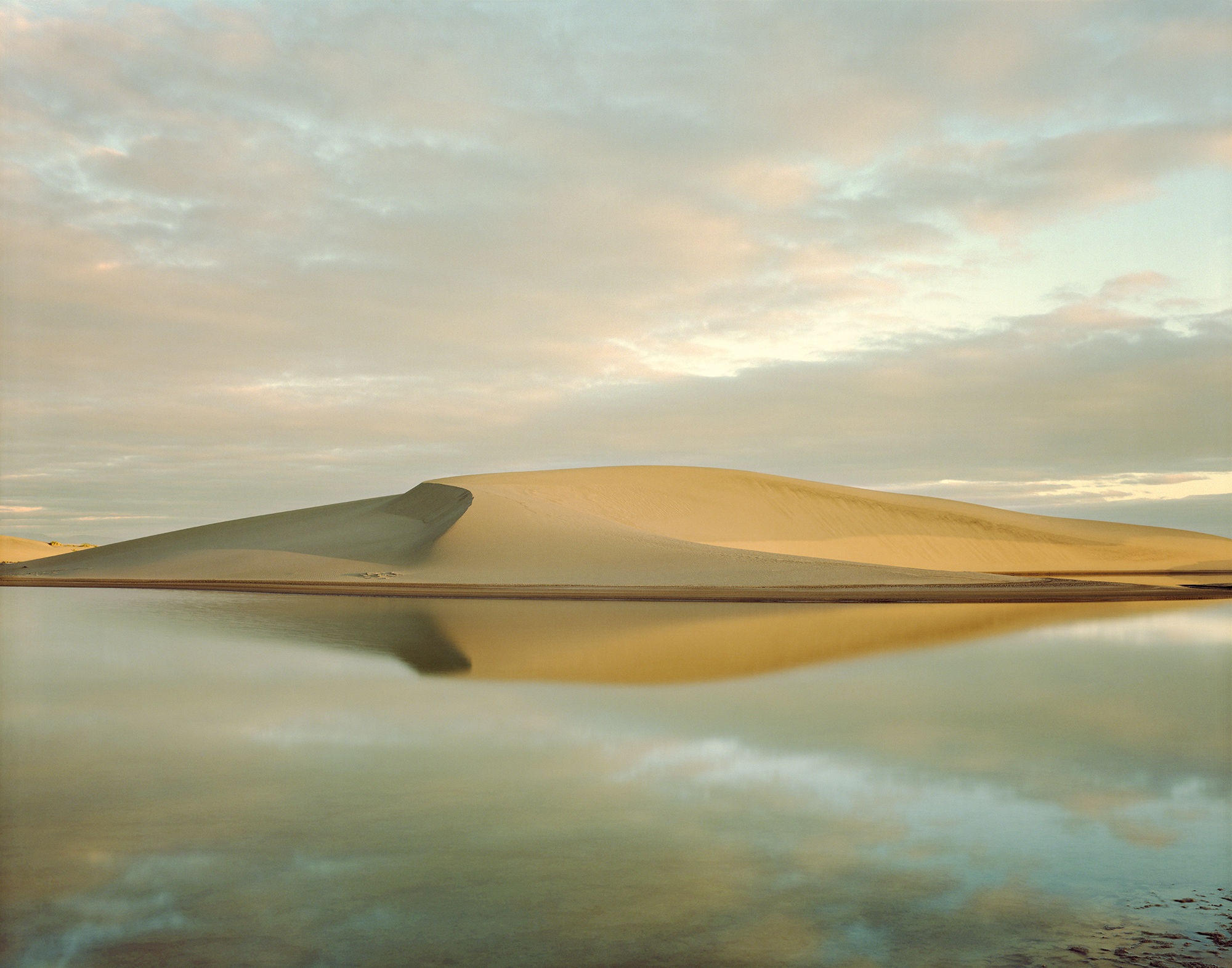
Richard Misrach. Battleground Point 20, 1999, pigment print. © Richard Misrach, Courtesy of the artist.
M.A. Blanco: Looking at the past, how did you live the 1960 political and cultural revolution? How does it influence your work if so?
R. Misrach: I went to UC Berkeley 1967-1971. When I got there, it was the height of the Vietnam war, and Berkeley was the center of protest. Academics were seriously disrupted, and I became involved. At the same time I was learning photography, mostly inspired by the f64 school (Ansel Adams, Edward Weston, et al). Photographically I was learning classical black and white, large-format, image making, but the surrounding political environment quickly started intervening. I soon became aware of and appreciated the power of photography to address social documentary issues from the likes of Dorothea Lange, Bruce Davidson, and my mentor at the ASUC Studio on campus where I was learning, Roger Minick.
M.A. Blanco: When you took clases at the University of California, Berkeley, between 1967-71: did any profesor influence your career in a key way?
R. Misrach: I took a couple of classes in photography, but I was really at Berkeley for traditional academics, starting out as a math major and ending up with a degree in Psychology. It was at the non-academic studio on campus—the ASUC Studio [Associated Students of the University of California]—where I learned photography. They had an analog lab with enlargers and developer trays and a staff that would show one the fundamentals. The staff there, particularly the director, Roger Minick, set an example—old style apprentice model, really—of making work. Show us how to develop film and print, then fine tune our printing and ultimately edit and make books.
M.A. Blanco: Having in mind the beauty of your negatives printed, I am aware of the importance of beauty in the 21th Century. Of course, the concept of beauty has changed over time. Anyway, do you think that when it comes to landscape photography, does beauty still matter?
R. Misrach: I have said many times, “beauty is a very powerful delivery system”. Like humor, (in the USA comedians like Stephen Colbert or Jon Stewart have an important place in public politics), beauty can be a very effective means of conveying complex political ideas.
M.A. Blanco: Destroy this memory is a very strong body of work, and I find the way how you discovered the theme very fascinating. How did you feel while photographing the aftermath of Hurricane Katrina?
R. Misrach: The work in Destroy this Memory is a small portion of the work that I did after Hurricane Katrina. I released that series on the 5th anniversary. I am planning on releasing the remainder of the project in 2025, the 20th anniversary. My reasoning is that I did not want to contribute to the tragic spectacle of the moment, but felt that the documents, and my “bearing witness,” would be equally important for the future record. Photographing tragedies like Katrina is very difficult. I have thought about that a lot. We must have some mechanism that allows us to put aside the horror that we witness, so as to be effective in getting the job done, whatever that may be. Surgeons or war photographers or firemen must utilize that mental/emotional muscle—to detach from what would normally be shocking or upsetting and go to work.

Richard Misrach. Broken Dreams, New Orleans, 2005, pigment print. © Richard Misrach, Courtesy of the artist.
M.A. Blanco: In the Anthropocene, photography may be understood as a way of rethinking man’s relation to nature. When I mention the Anthropocene era, I am interested in knowing your point of view about how photography becomes a powerful way of learning. I mean: do you think people’s minds can be changed through photography and people could be more aware of the urgent necessity of rethinking their relationship with nature thanks to photography?
R. Misrach: I honestly don’t know. For me, making the photographs is very much about mediating our relationship with the natural world... for myself. I can’t say what others might take away from my photographs, or photographs in general. But for me, making the photographs is an intense personal (existential) dialogue with the world (and the concept of second nature), but I can’t be sure that’s how others receive them.
M.A. Blanco: From your perspective, how will human-altered landscape photography evolve in the coming decades, in the near future?
R. Misrach: Not sure, obviously social media is going to be a huge platform, with new forms of art/photo practice being possible. I love what I do, and I don’t even do any social media, so this will be for the next generation.
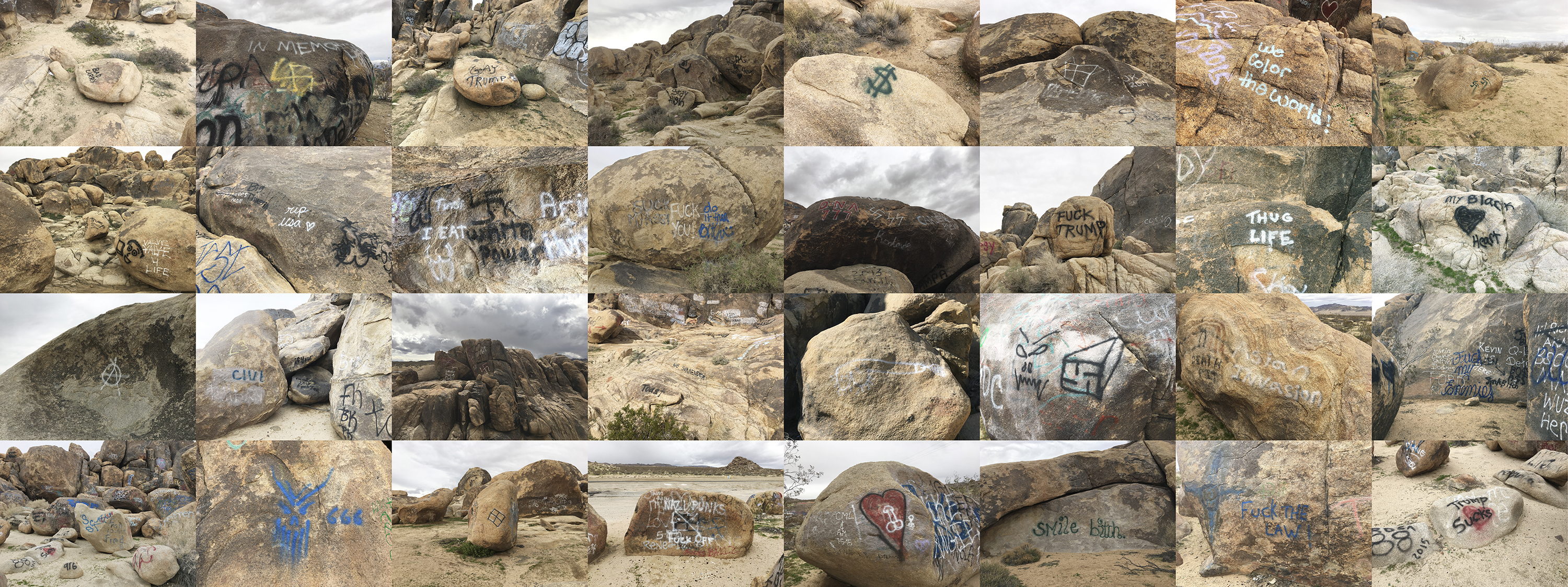
Richard Misrach. Tagged Boulders (nazi grid), Lucerne Valley, California, 2017, pigment print. © Richard Misrach, Courtesy of the artist.
M.A. Blanco: Regarding the “second nature” idea, this idea came to my mind as a result of my research on human-altered landscape photography through your work as well as many other photographers’ work, including Peter Goin’s Humanature project. I mean a new nature which is being increasingly redifined by the assumed “progress” of humankind.
R. Misrach: Yes, second nature is simply a fact if life—there is no going back. Only adapting. And the question will how well we adapt. Being just one person, my goals are fairly modest... Ezra Pound said something to the effect, “It is the artist’s responsibility to portray his/her world”. Also, you should be aware of this ambitious, monster global warming project for summer 2021, called The Extraction Project4. The extraction project is an example of the potential for cumulative and cooperative efforts. Along with the group mentioned, I’ve contacted other organizations, like For Freedoms who are thinking of doing an independent, but simultaneous global billboard project with artists about global warming for the summer of 2021. I’ve also shared this idea with Aperture, MoMA, Pop-up magazines, etc. Perhaps a cumulative model is a way to have a bigger impact.
I think in general you are trying to figure out: does photography/art/esthetics have a role in combating the environmental danger facing us? I do believe esthetics whether in poetry, music, painting or photography have a crucial, powerful role in both bearing witness (History Painting for me is another model) and in creating values.
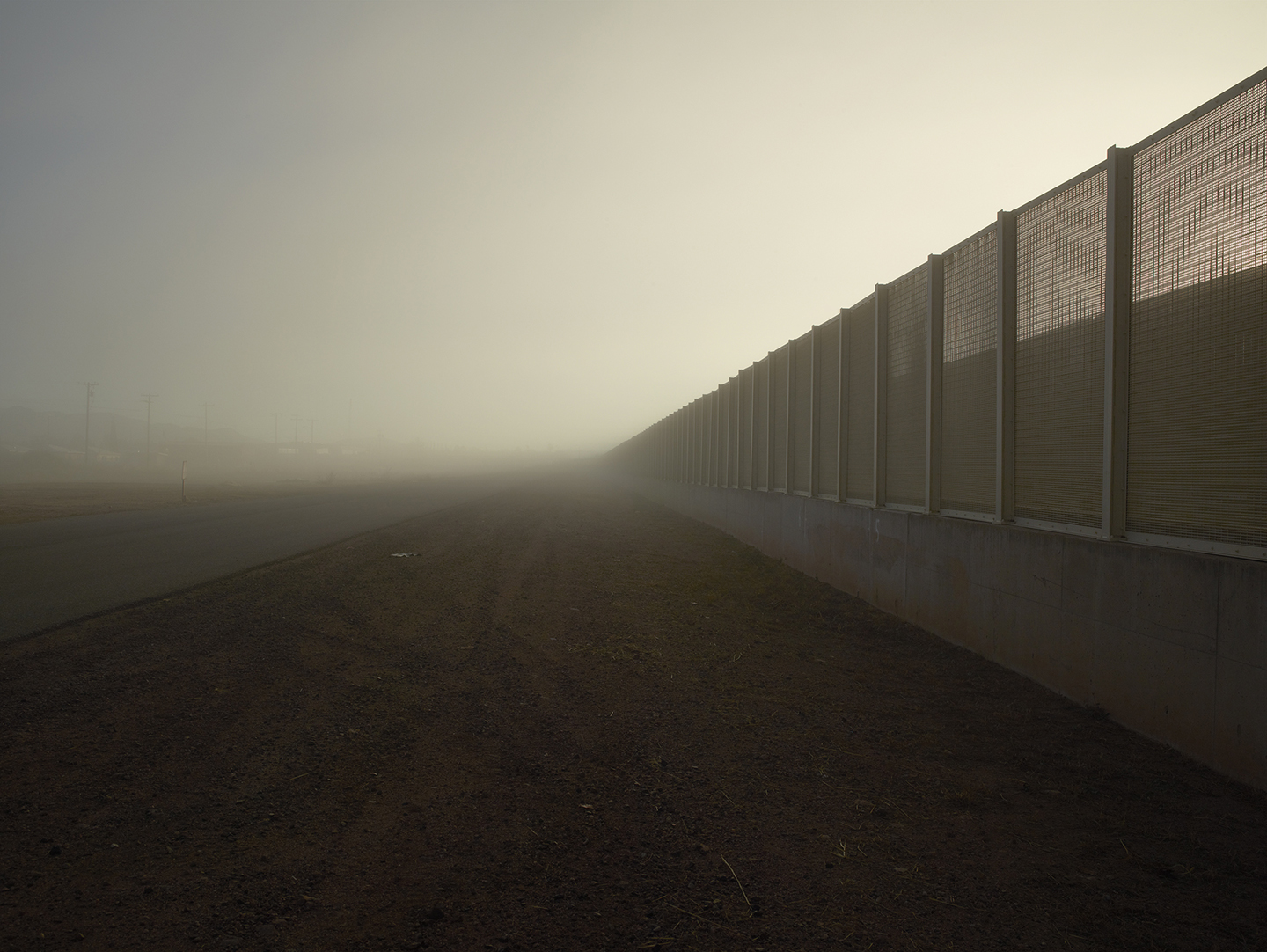
Richard Misrach. Wall (post and wire mesh), Douglas, Arizona, 2014, pigment print. © Richard Misrach, Courtesy of the artist.
2. Thinking of a new nature with Peter Goin
M.A. Blanco: When it comes to contemporary photography, should we think of an anthropology of images in a post-human world?
P. Goin: I wouldn’t necessary identify contemporary photography as existing in a post-human world, for if no one is around to view the images…do they then exist? A rhetorical question; indeed. But more to the spirit of your question, which is the interface between contemporary photography and anthropology. Of necessity, and due to photography’s essential identity – it’s connection to The Real – contemporary landscape photography is by its very nature anthropological, although I would probably prefer a slightly more relevant term.
M.A. Blanco: Today, when environmental awareness is influencing people’s lives, is photography participating in this challenge?
P. Goin: Photography is inherently woven within the environmental ethic, but, of course, not all photography is about the environment. It should be important to note that even the gatekeepers in museums and galleries often avoid landscape photography because of its polemic.
M.A. Blanco: Does beauty still matter? How would you define beauty in the 21th Century?
P. Goin: Beauty is inevitable within the human spirit and is omnipresent in landscape and even post-New Topographical photography. The difference is that beauty is being continually redefined, perhaps approaching a closer association with eloquence than with the more traditional and predictable forms of aesthetic beauty.
M.A. Blanco: Where is the beginning of your changing landscape photographs?
P. Goin: …probably when I traveled for nearly eight months in Mexico and Central America, whereupon I negotiated the conceptual paradox of ruins becoming nature and nature becoming ruined.
M.A. Blanco: Why do you include words in some of you photographs?
P. Goin: In those cases, the photograph is not intended for the traditional view of ‘a photograph should emulate or represent beauty’ but, instead, a more mediated polemic of how humans view the world through lens of appropriation, framing (even within the box of a television or a smart phone screen), and identification. Have you ever noticed how in the daily news, it’s imperative for every scene to be identified with text at the bottom of the screen? That’s certainly one influence, but another, less recognized influence is the theatrical works of Bertolt Brecht. In his ‘narratives,’ the dialectical theater espouses political, confrontational, and documentary theater. His plays broke the illusion of the ongoing narrative whereby songs or dialogue interrupted the proceedings, speaking or singing directly ‘to’ the audience, acknowledging their presence. Theater often treats its audience as silent and anonymous voyeurs, rather than active participants, even if just by ‘being included’ in the meaning or debate of the narrative. I’m not speaking about Brecht’s influence by the Marxist dialectic, but more about the focus on the idea that the theater is not reality but a rational self-reflection of a critical view of what’s portrayed. In part, this explains why the text appropriates the viewer into a conversation about that what is being pictured.
M.A. Blanco: Why are you interested in California agriculture? How did you decide to be engaged in your A field Guide to California Agriculture project?
P. Goin: Agriculture is one of the oldest human practices and is essential for evolving civilization. Yet, within contemporary art practice, it is – and this is only an anecdotal observation – relatively ignored. From my point of view, agriculture is the new nature, a different way of understanding human’s cultivation of that which we call ‘nature.’ The project that became the Field Guide to California Agriculture came from literally years of discussion, almost always punctuated by the amazing realization that no such guide had ever existed, previously. And to present a guide that wasn’t literally a guide but more of a series of connected essays and photographs about our relationship to the food we consume became ever-increasingly important. The specific focus within some communities on the food-we-eat and where it comes from, the unfairness of regional agri-racism, the presence of creative solutions responding to the pressures on ranching and farming (food co-ops, conservation trusts, et al), and the stories we could tell, resulted in the published Guide. After all is said and done, agricultural landscapes are the most historically managed landscapes of all.

Peter Goin. Bees in Cherry Orchard, Blossoms, Santa Clara Valley, 2007, digital pigment print. © Peter Goin, Courtesy of the artist.
M.A. Blanco: Regarding your Humanature project, I am especially interested in it. Please, could you tell me about the root of this project?
P. Goin: This is the preface for the book, and although it is somewhat of an ephemeral story, the fact is that I had been working on the intersection of that which we call ‘nature’ and the built environment for most of my career, especially since my travels exploring the Mesoamerican ruins in Mexico and Guatemala.
M.A. Blanco: Is a “second nature” definition possible through contemporary landscape photography? If so, how would you define it?
P. Goin: Humanature is, in focused ways, an argument for that ‘second nature.’ When you ask if a ‘second nature’ is possible through contemporary landscape photography, presumably your meaning implies that artists currently working with this idea are defining a ‘new’ aesthetic. And, yes, I would agree, although the actual language will vary from artist to artist.
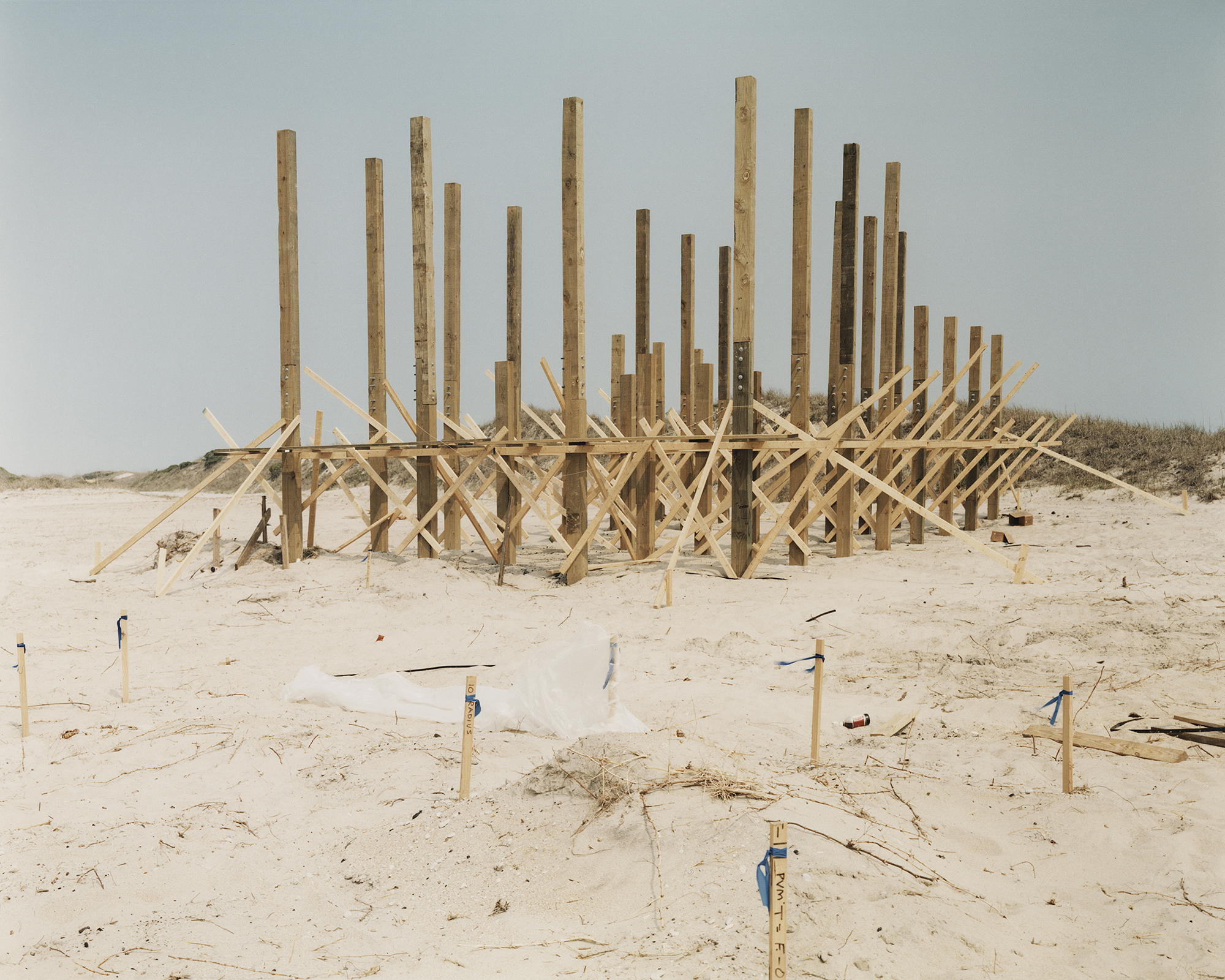
Peter Goin. Public beach access structure under construction north of Surf City, North Carolina, on the Outer Banks, 1992, digital pigment print. © Peter Goin, Courtesy of the artist.
M.A. Blanco: How much is the Anthropocene era influencing photographers’ work?
P. Goin: The Anthropocene is the current geological era acknowledging the role of human activity as a dominant influence on the climate and the environment. The argument for this role is inescapable; even the advent of the nuclear era has transformed the global environment – nearly a 7% increase in radioactivity, everywhere. What consequences will emerge only time can reveal, but in many cases, photographers are responding to the world in which they live by bearing witness, to whatever they see and feel. Their responses may not be entirely focused on the environment, but all of life is interwoven, so the destruction of a hurricane has personal stories and the visual narratives that accompany them. Is this responding to the Anthropocene era? Indeed. Even the sentimental efforts to present ‘nature’ as untrammeled are reactions to the built cacophony of concrete jungles.
M.A. Blanco: Taking into consideration the human-altered world where we live, what photographers’ contribution would be a good one in today society? I mean, how photographic creation may have a positive effect on humankind.
P. Goin: At the end of the day, I am a realist, with a healthy spice of optimism. Artists, not just photographers, bear witness to the world, share their visions, and make efforts to educate the rest of us, and by creating eloquent interpretations of ourselves, offer us hope in a crazy, scary, and fractured global community. I recognize that photographers cannot change – entirely – the course of history, but that one photograph from space of the planet earth sparked an awareness that we are alone and that we must take care of the home planet where we live. And while this is important, so is our dedication to visual literacy so that we can acknowledge that photography can be, left unchallenged, a tool of oppression, of colonialism, of desire and neglect.
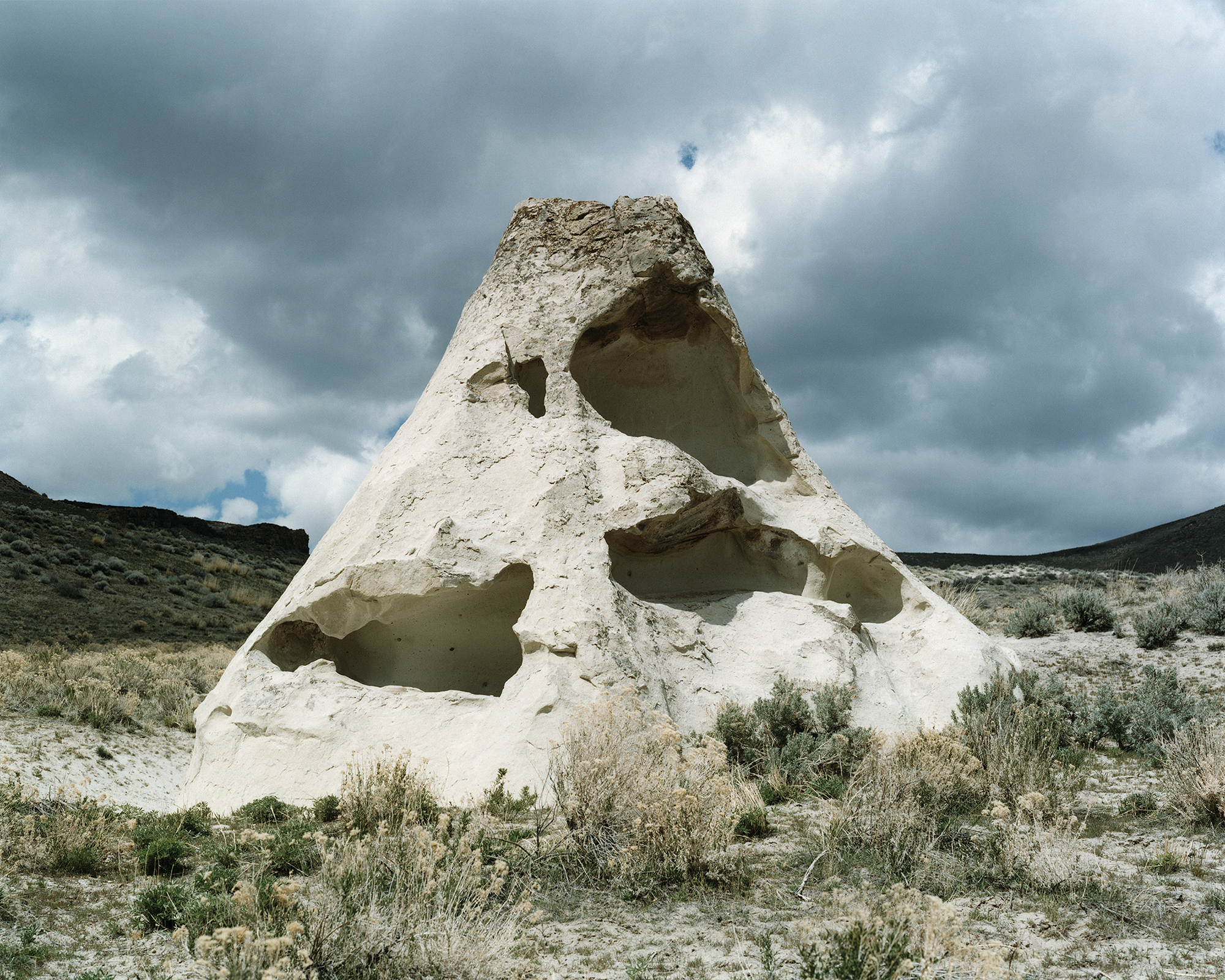
Peter Goin. Triangle rock, Negro Creek, Black Rock Desert, 2003, digital pigment print. © Peter Goin, Courtesy of the artist.
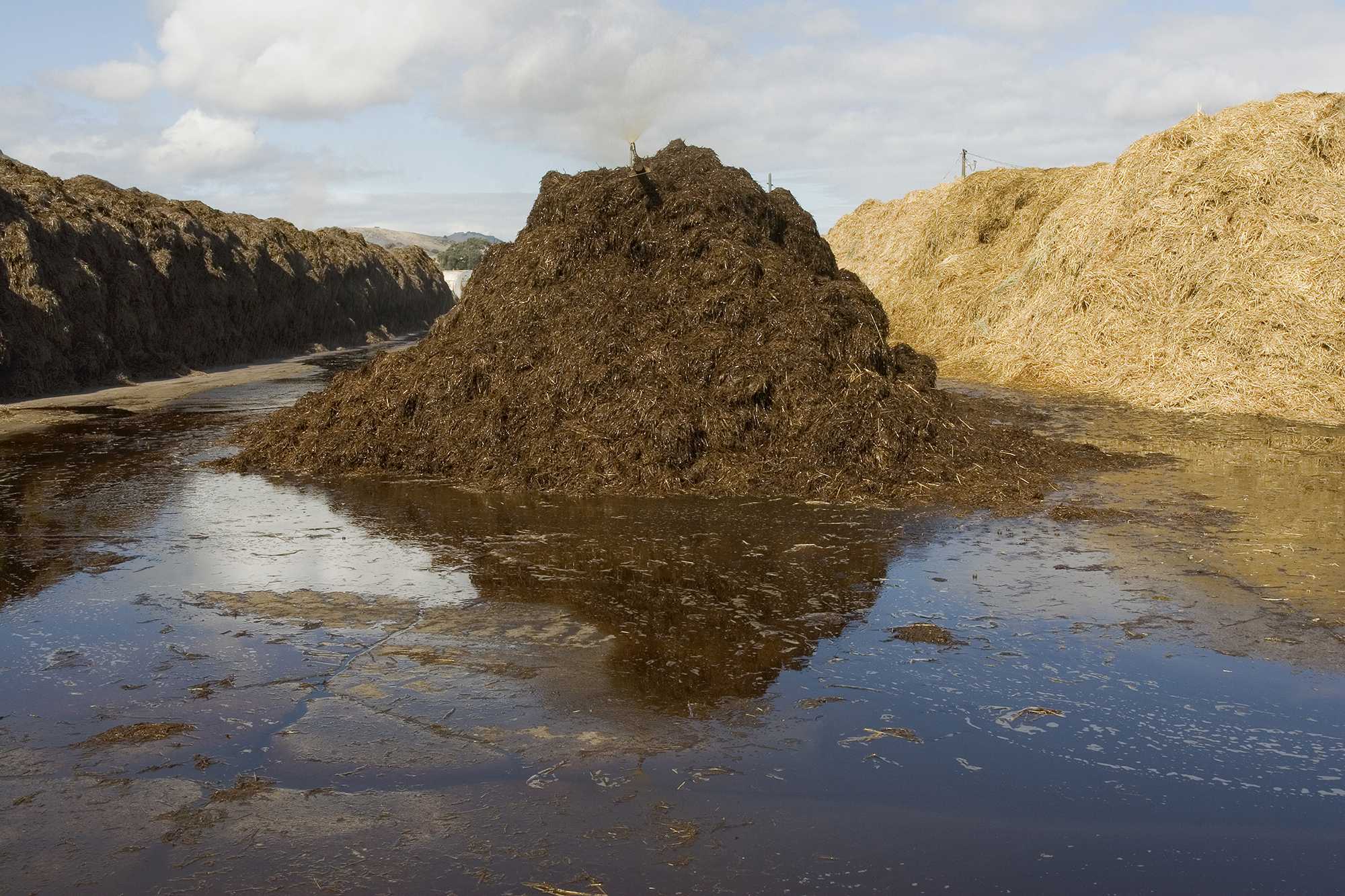
Peter Goin. The End of the Compost Row, Monterey Mushrooms, Morgan Hill, 2006, digital pigment print. © Peter Goin, Courtesy of the artist.
3. Looking to the past and present with Jack Fulton
M.A. Blanco: I am very interested in knowing how, as a photographer, you would define your relationship with nature. Could you, please, tell me about this?
J. Fulton: Nature, with the word capitalized, is my ‘spiritual’ understanding/belief of what the mystery of life is. Dogma of the world’s religions does have many good and intelligent things to say but I feel to experience Nature provides one with similar understandings.
M.A. Blanco: Besides, I am curious to know why you started taking photographs when you lost your job. Why did you decide to be involved in photography instead of any other way of making art like painting, etc?
J. Fulton: I had been on a career path having studio engineering, which at that point in time was not something I wanted to be. Dad was an engineer but was a pretty good painter as a youth. Mom was a highly skilled elocutionist, reciting Scottish poetry and had won a medal for it. All of our friends ironically were artists: sculptor, painter, poet, filmmaker, ceramics, etc. Frankly I was intimidated and knew photography was practices by few as an art so I chose that as my way to express myself.
M.A. Blanco: Because of my special interest in Ansel Adams’s work, for me, it is truly amazing to know that you met him. Could you, please, tell me how was your relationship with Adams?
J. Fulton: I did not have a ‘relationship’ with Ansel. However he had started the department of photography at the San Francisco Art Institute where I began to teach. Teaching was an important link to the important practitioners of that time and a group, Society For Photographic Education (SPE) was founded to address needs of educators. Many of us loved Ansel, who basically was photography’s first super star so to speak. Conferences in the western division of SPE were often held at Asilomar near where Ansel, Wynn Bullock, Morley Baer lived and also Edward Weston. The area of Carmel was a center (and remains so) for photographers who cherished the fine print, followed Ansel’s ideas in his Zone System and it was a fine place for discussing the medium and it ramifications and future. I took classes there to get a ‘feel’ of the place and once Ansel invited my class to his house, which they adored and he was very generous to them with his time.
M.A. Blanco: From your experience, do you think that Ansel Adams thought of the scale of how we would altere landscape someday? I know that he sometimes altered his negatives in order not to show human evidences.
J. Fulton: I had not realized Ansel had done that and I cannot say what he thought about “altering” landscape art. He was a fastidious worked, his wife was from the Best Studios in the Yosemite Valey and he lived there and had chances few have had to photograph all year long. However he did extensive work with the Sierra Club and aided to produce the 1st really high quality color photography book by Eliot Porter: The Place No One Knew.
In short, Ansel was highly influential for many of us beginning photographers who cherished Nature, the wilderness and were interested in using the medium for ecological purpose and environmental preservations.
M.A. Blanco: I know that Ansel Adams’s work is a reference for you. Besides, taking into consideration your way of understanding landscape photography as exploration, how does Adams’s work influence your photographic work?
J. Fulton: Essentially it was his passion in understanding how photography and its “truth” in regarding the wonders of the environment and to point out to people how important it was in a spiritual sense to one’s being.
I take very seriously in my life and have passed that love on to our two daughters who work with the environment.
M.A. Blanco: As a chair of the department of the San Francisco Art Institute, what was your approach to photography?
J. Fulton: To have it be considered equal to the other ‘fine’ arts’ taught at the school, to make the medium be explicit but yet open to all possibilities. I brought large grants to the department to triple its size, introduce color as a tool, brought alternative practices to the teaching and simply wanted the department to support any and all kinds of photographic expression. I held no biases such as following in Ansel’s footsteps and making the place a ‘landscape mecca’. I worked to make it a place with excellent teachers who taught both a philosophy and yet held the print to be the final expression.
M.A. Blanco: From your point of view, what do you think it is going on when it comes to human-altered landscape photography?
J. Fulton: Good question and I hope the reply is not too simple. The genre of landscape photography is not filled with cliches as countless thousands make and take photographs of the landscape. This who alter the photograph, perhaps coloring b&w work, or juxtaposing historic imagery with current photographs of the same place to exhibit how times have changed are all expressive and valid ways to be current, to emphasize the importance of the soulful aspect of the land, or to make a social comment in order to curb exploitation of Nature. We live in a world of 89+ billion people. When Ansel was working, the world was 2.3 billion. Greater and greater exploitation and subsequent ruination of the land is in progress at full tilt so rather than show the ‘old style’ of landscape photographic imagery, new ways have been devised to make the artist’s point of view more adamant. Suck changes are, in my mind, necessary.
M.A. Blanco: What do you want to communicate through your photographs? Is it about multidisciplinary knowledge? I find your Two Saunters book specially interesting, since you mix photography with painting and writings, what, I think, is a very amazing way of expressing your perception of the world.
J. Fulton: Yes, I do use various materials + text + different methods in my work. Thank you for seeing Two Saunters as an interesting combination. Overall, now within heartbeat of being 89 years of age, the realization is that my work overall is a very full, and hopefully insightful, manifestation of kith experiences, understandings and truth of this life I have led. So, quickly, I want that work to “look” good, to have others see it is well thought out, as varied in content and style and of a rich life well led. The ultimate hope is for the viewer to realize how important it is to be fully involved with life, and to vividly see how beautiful and spiritual Nature is in regard to the meaning of life.
M.A. Blanco: How important is beauty in your work?
J. Fulton: I hope it is evident in the work you have seen, that it is one of the prime aspects in my oeuvre. I love beauty, and quote (or misquote) Keats and his “Ode On Grecian Urn”: ‘Beauty is truth, truth beauty,’ — that is all you know on earth, and all you need to know.
M.A. Blanco: Does ecology or sustainability play an important role in your current artwork?
J. Fulton: Yes. Both aspects are thought about on a daily basis. Even more so in light of the United States current government which is ruinous, ugly, greedy and thoughtless. Hence my (and others I hope) work and the content is more necessary than ever.
4. Conclusions
Photographers Richard Misrach, Peter Goin and Jack Fulton’s work makes us more aware of the vulnerability and beauty of nature, so photography becomes an important educational tool. If we ask ourselves, “what can photography teach us?” we will discover the wonderful educational power of photography. Some time ago, the photographers Harry Callahan and Edward Weston supported the educational function of the camera, since they did not consider it as a simple tool. Today, photography is responsible for the growth of environmental awareness and it influences the preservation of nature. These three photographers interviewed share this approach, and they address a profound perception while exploring nature, as they spend hours or even days in the middle of nature. Having said this, the environment where they take photographs provides them with a unique experience, which is an essential ingredient of a conversation between artists and landscape.
Moreover, photographers are not only aware of the transformation of landscape, but also, they transform landscape perception in the current altered world, and their projects are a turning point to rethink a multidisciplinary environment where sustainability, history, art or philosophy make sense together and provide us with a global understanding of the altered world. The question is: how photographers transform our landscape perception in the altered world?
To sum up, it can be said that these photographers’ work is an invitation to establish endless connections in the global world where we live. When different thoughts from landscape photography come together, we realize that artists are taking part in a global conversation about nature and humankind. Every action and photograph is part of this “conversation”, and photography is not just an art language, but the language of a new kind of nature (in a post-natural world) we need to think about.
Acknowledgement
My gratitude to Richard Misrach, Peter Goin and Jack Fulton, who have been very generous with their time and have allowed me to reproduce their photographs.
This article is the result of a research stay funded within the framework of the program “Campus de Excelencia Internacional del Ministerio de Educación, Cultura y Deporte”. Funding Institution: Universidad de Sevilla, within the “Acuerdo Marco entre Andalucía TECH, VLC Campus y la Universidad de California (Berkeley)”.
References
Fulton, J. (1986). Two Saunters: Summer & Winter. San Rafael, California: Pencil Press.
Goin, P. (1996). Humanature. Texas: University of Texas Press.
Misrach, R. & Lignel, B. (2016). Richard Misrach. Italy: Photographers’ References.
Notas